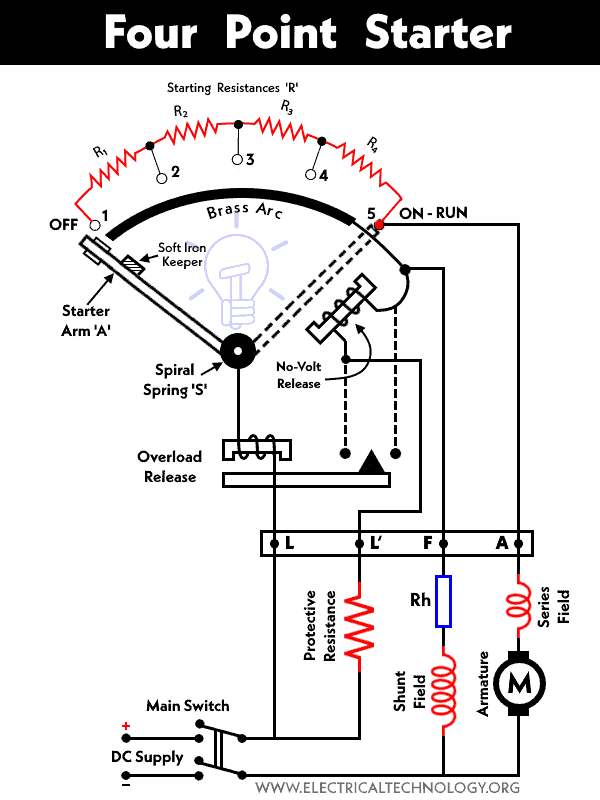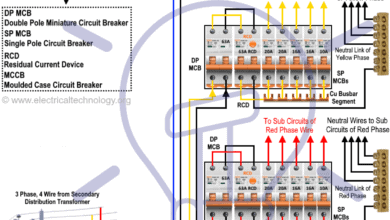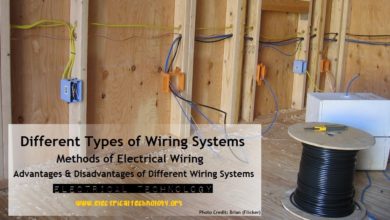4-Point Starter – Circuit and Working of Four-Point Starter
What is Four-Point Starter? Working and Circuit Diagram of 4-Point Starter
What is a Four-Point Starter?
The construction and working principle of a Four-Point starter is almost similar to the working of a three-point starter. It is used to limit starting current and also used as a speed control and protective device. Similar to a three-point starter, this starter also consists of a No-volt coil (NVC) and an overload trip coil (OTC).
Construction
As the name suggests, a Four-Point starter consists of four terminals named L, N, F, and A. The connection diagram of the Four-Point starter is shown in the figure below.
One end of the armature winding terminal is connected to point A and one end of the shunt field winding is connected to point F. Remaining terminals of the armature winding and field winding are connected with the negative terminal of the DC supply.
No-volt trip coil (NVC) and a current limiting resistance (R) is connected in series with the line terminal of the DC supply. One end (ON) of the handle is connected to the remaining terminal of the NVC. And the second terminal of the handle (OFF) is connected with terminal L through an overload trip coil (OLC).
The handle is hinged with spring and due to spiral force, it remains at the OFF position when the motor is in a standstill condition. During starting period of the motor, the handle moves manually against the spiral force to the OFF to ON position.
Working
The working principle of a Four-Point starter is almost similar to the working principle of a three-point starter. In standstill condition, the handle arm is placed at the OFF position. When the DC supply is five to the motor and the arm is moved to the first stud of starting resistance, the current divides into three branches;
- Armature winding and starting resistance
- Shunt field winding
- No-volt release coil and protective resistance
Here, the no-volt release coil is a separate circuit from shunt field winding. Hence, the current that passes through the shunt field winding is separate from the current that passes through the no-volt release coil. Therefore, the electromagnetic pull generated by a no-volt coil is always sufficient to attract an iron keeper.
A rheostat is connected in series with the field winding. This field rheostat is used to obtain the speed of the motor above normal speed. Here, we need to assure that;
- The field winding is closed before starting the motor,
- The field rheostat connected in series with the shunt winding is set at zero resistance position,
- And the starting resistance in series with the armature winding is at maximum value.
Similar to a three-point starter, if in case the supply is failed, the current passes through the no-volt coil are zero and the arm is pulled back to the OFF position. And in case of overload, the overload coil generates enough MMF to pull plunger P and short the terminals of the No-volt coil. This makes zero current in the no-volt coil and the arm is pulled back to the OFF position.
Disadvantage
The only disadvantage of a Four-Point starter is that it does not protect against failure or open circuits in the field winding. The field failure condition is rare in practice but it is a very dangerous condition.
Because if the field winding is open-circuited due to any reason, the only flux available is due to residual flux. And the residual flux is very small. And we know that the speed of the motor is inversely proportional to the flux N ∝ 1/ϕ.
So, the motor runs at dangerously high speed. This protection is considered in a three-point starter.
Related Posts:
- What is Motor Starter? Types of Motor Starters and Motor Starting Methods
- What is a Contactor ? Types, Working and Applications
- What is the Necessity of a Starter in AC and DC Motors?
- Star Delta Starter – (Y-Δ) Starter Power, Control and Wiring Connection
- Direct Online Starter – DOL Starter Wiring Diagram for Motors
- What is Soft Starter? Its Working, Diagram and Applications
- Speed Control of DC Motor – Voltage, Rheostatic & Flux Control Methods
- Three-Point Starter – Circuit and Working of 3-Point Starter
- Four-Point Starter – Circuit and Working of 4-Point Starter
- Main Difference between Contactor and Starter
- Cable Size Calculation for LT and HT Motors
- Starting & Stopping of 3-Phase Motor from more than One Place Power & Control diagrams
- Three Phase Motor Power & Control Wiring Diagrams







